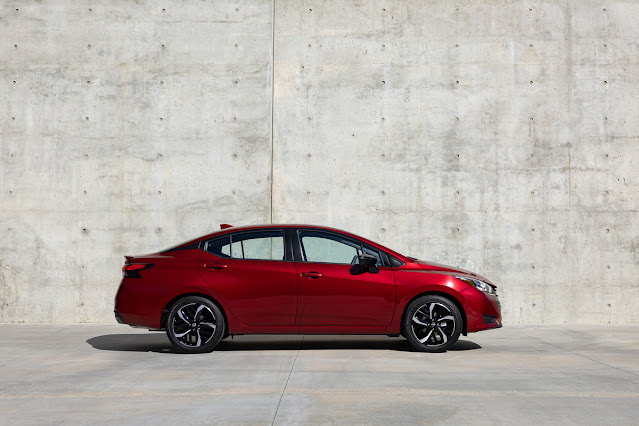On August 15, 2023, Automotive News (paywalled site) reported Mitsubishi may be discontinuing its thrifty Mirage model after MY2024. This really isn't that much of a surprise since automakers have been abandoning the subcompact market for years now in North America. (Mitsubishi Japan already killed off the Mirage, FYI.) Then today, I heard word via Carscoops Kia is going to stop selling its Rio in the U.S. This leaves just the MINI brand and its small cars and the Nissan Versa as the sole subcompact car offerings in the U.S. I'm not surprised.
Numerous outlets have reached out to Mitsubishi's PR team, who've declined official comment. However, the current Mirage platform, which debuted as a 2014 model year, is aged. Most have speculated that 2024 will be the Mirage's final model year, at least in this form. No word if it'll be replaced. Given the current automotive climate, I doubt it will be. If it is, it'll probably be a compact CUV. Just my hunch.
Kia, on the other hand, has apparently confirmed that 2023 will be the last year for the Rio in the U.S. It's been dead in Europe and Australia, so this also shouldn't be too surprising either.
Why Small Cars Have Disappeared
 |
| 2013 Fiat 500c Abarth |
Many people think small cars have disappeared simply because auto manufacturers don't promote them. That's not 100% true.
A manufacturer's public relations contact, wishing to remain anonymous, recently told me, that the federal requirements for having all the safety (and accompanying tech) is one reason why cars have become so expensive, further eroding the profitability of small cars which already had a slim (if any) profit. They've become too expensive to produce and make money on. Therefore it doesn't make sense (or cents) to invest gobs of marking dollars into small cars that don't make much money and are getting more pricey regardless. It's a bit of a chicken/egg scenario: small cars don't get marketed, and people don't buy them. People don't buy them, and then they don't get popular. They don't get popular because they're not marketed ... and the cycle continues.
The average transaction price of a new car in July 2023 was a semi-astonishing $48,344 according to Kelly Blue Book. Apparently, if you are going to spend just $20,000, most people will buy a higher-end used car than a lower-end new car. Such is the way of the world these days.
It should also be noted that bigger cars are getting much better fuel economy than ever before, even non-hybrid or EVs. We just returned from
Boxerfest in Pennsylvania where we had a 2023 Nissan Sentra SV rental car (MSRP: $21,420 before tax, title, and destination). We put a few hundred miles on it and averaged over 40 MPG combined. That is damn impressive—and a lot roomier than a Mirage or Rio.
 |
| Toyota Aygo X in Iceland |
We recently got back from a two-week trip to Iceland where small cars are alive and well. We saw numerous Kia Picanto hatchbacks, Toyota Aygo X, Hyundai i10, a host of French-made subcompacts, and countless Suzuki Jimny models. It made me a bit sad to think that none of these are available for purchase back in The States. I'd snag any of these given the chance, especially the Jimny.
The Bigger Small Car Picture
 |
| 2023 Nissan Versa. Image via Nissan. |
Mirage and Rio were two of the last "affordable" cars left on the U.S. market, and the Mirage was the least expensive new car out there. Regardless of price, it leaves just the MINI models and the Nissan Versa as the lone subcompact cars on the market. By "cars" I mean sedans or hatchbacks, not CUVs or SUVs. At the time of this writing, the least expensive MINI starts at $25,800 USD; the least expensive Versa starts at $15,980, but after destination, it's $17,075 and that's before tax, title, and license. Also, the Versa isn't exactly tiny anymore with a 103" wheelbase and 177" overall length. That's 25.6" longer than a 2024 Mirage hatchback.
OK, you might be thinking, what about the Kia Soul? Kia calls it a crossover, and I'm sure that's done to help bolster sales because no one buys hatchbacks, right? [INSERT TONUGE INTO CHEEK]
Small CUVs and SUVs Still Around
 |
| 2024 Hyundai Venue. Image via Hyundai |
Americans still allegedly don't like small hatchbacks (or sedans) unless you call them crossovers or sport-utility vehicles—then they're amazing, even if they're really just hatchbacks. So yes, vehicles like the Kia Soul and Seltos, Nissan Kicks, Chevrolet Trax, Honda HR-V, Mazda CX-30, Hyundai Kona and Venue, and Subaru Crosstrek (among others) are likely hanging around. Granted, most are bigger than the subcompacts of the mid-to-late 2000s. While the segment has always been in a bit of a gray area, I used to say it was a subcompact if the wheelbase was under 100". But even that has been a bit misleading.
But buyers in the U.S. are in love with crossovers, and that's just the way it is. Hell, we even sold our 2017 Mitsubishi Mirage and eventually our 2007 Toyota Yaris in favor of a 2022 Subaru Crosstrek. So perhaps we're part of the problem. But, realistically, automakers have to sell scads of tiny cars at tiny profit margins to make money, and this is a business after all.
So, at least at this time in U.S. automotive history, the subcompact market is all but dead. Long live subcompact cars.






2 comments:
This is affecting all north american market indeed
Hi, Andy
This is Jason, a regular visitor of your blog from Shanghai China.
You might never image that the dying subcompact segment in US got a re-birth in China, but this time in form of EV. Here is just one example. https://www.youtube.com/watch?v=anoliCXXKIA
I enjoy your blog as I love subcompact too. Thanks for all your posts,
Have a good one,
Jason
Post a Comment